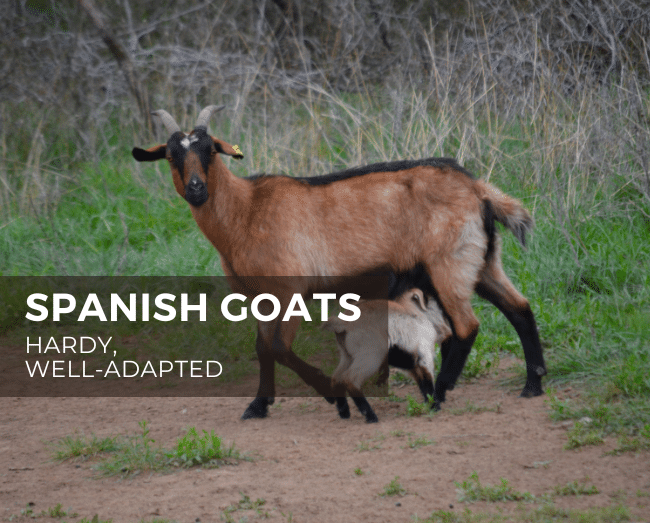Especially popular in Texas, the Spanish goat breed is among the most tolerant of goat breeds, particularly when it comes to climate and parasites. This article will go over the specifics of the Spanish goat, including common breed characteristics and use.
Table of contents
History of the Spanish goat
First originating in Spain, the Spanish goat first made its way to the Caribbean Islands and then eventually to what is today considered Mexico and the United States in the 16th century.
As the Spanish explorers colonized throughout the Americas, some of the Spanish goat genes likely became mixed with other breeds as time went on but continued to be highly valuable as a source of milk, meat and hides.
Because of the distances traveled, the goats that came with the Spanish colonists were also incredibly hardy and that trait was passed down to the modern versions of the breed, which continues to be known for its resiliency.

Spanish Goat Photo Credit: Thank you to Bear Family Farms of Texas for permission to use this photo. You can learn more about the farm on their YouTube channel.
Spanish goat characteristics
Colors and coat
Spanish goats can be found in a variety of colors and patterns which can make things difficult when it comes to true identification. Some common colorings for the Spanish goat include dark brown with varying shades of black or light brown with white.
Spanish goat coats are generally on the short and smooth side but some can even grow heavy cashmere coats in the winter.
Size
Spanish goats body shape is medium-sized and demonstrate moderate growth. However, their size can vary, especially if Spanish goats are cross-bred with other meat goat breeds, such as the Boer goat.
Bucks can weigh anywhere from 90 to 350 pounds.
Horns
Spanish goats have large long horns that spiral in shape.Those crossed with other breeds, such as the Boer or Savanna goat tend to have horns that lack the distinctive spiral.
Temperament
Spanish goats can be difficult to handle and are quite alert and flighty in nature. They also have great natural mothering instincts.
Hardiness
As a breed, Spanish goats are incredibly hardy and are known for their resistance to internal parasites, though continued management and monitoring is still needed to help maintain it.
Spanish goat uses
Spanish goats are most frequently used for meat production. However, they also make for good brush goats for cleaning up land with invasive plant species and other undesirable brush..
Occasionally they’re used for dairy production but not as often due to their smaller udder size.
Where to buy Spanish goats
When considering buying Spanish goats, look for local farms or ranches raising them in order to have better success transitioning them to your own place.
Checking the Spanish goat breed organization and registry pages are good places to start when looking to locate breeders or Spanish goats in your region:
- American Spanish Goat Association
- Spanish Goat Registry
- Goat Rancher magazine Spanish goat breeder listings
References:
- American Spanish Goat Association, Breed Standards
- The Livestock Conservancy, Spanish Goat
- Spanish Goat Registry, History of Spanish Goats

Thank you for this great information and easy to read format!
You’re welcome! I’m glad you found my blog.